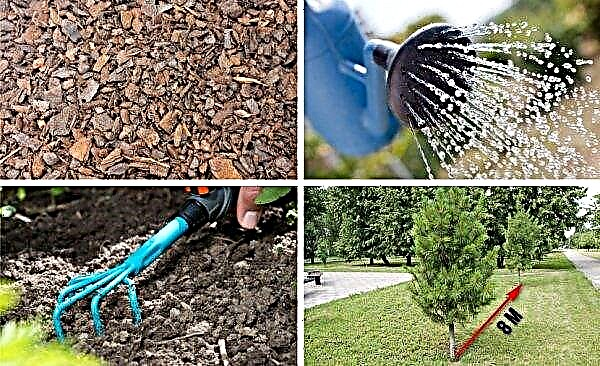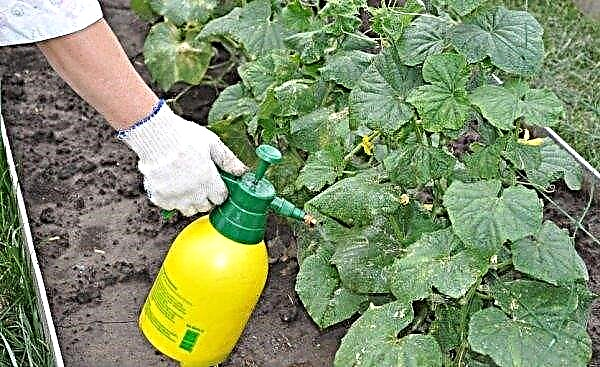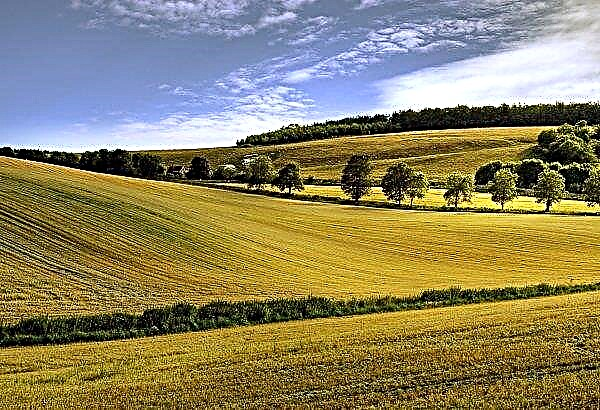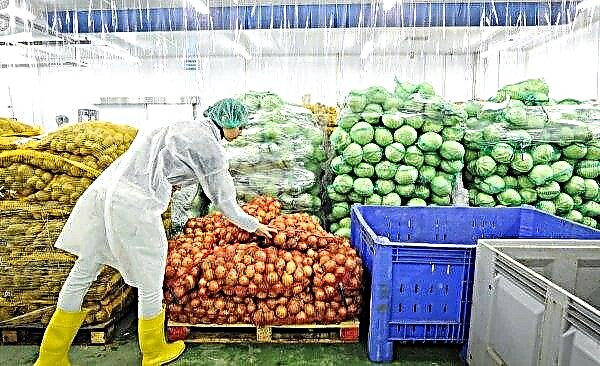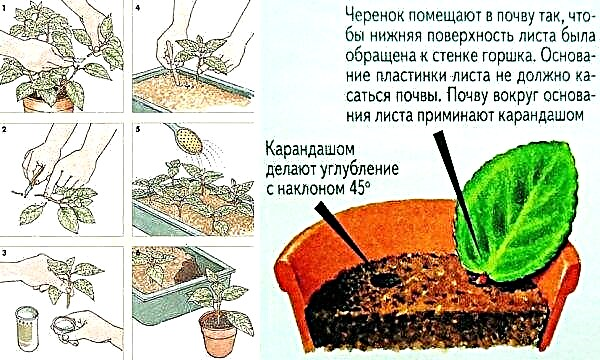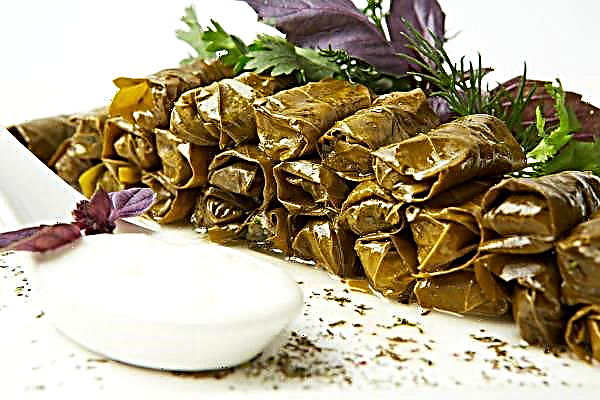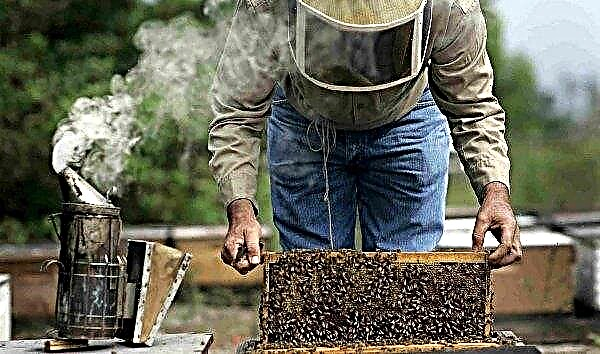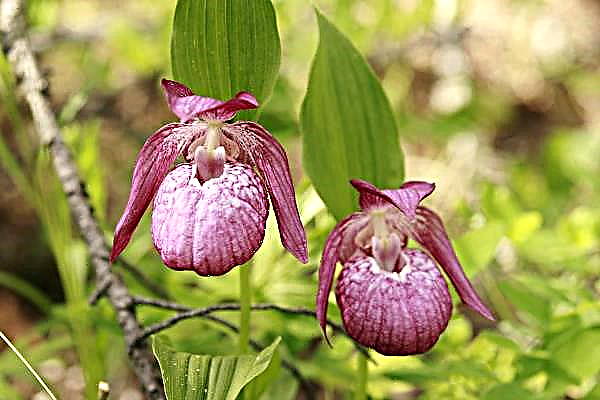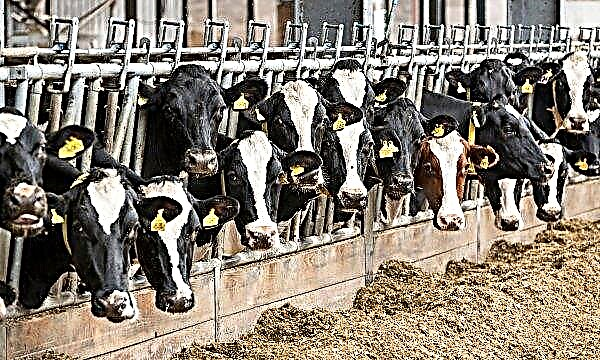Growing this culture will not be too time-consuming, because at the minimum cost you can get the maximum yield. Winter garlic, which is planted in the fall, is especially popular with gardeners. How to grow spicy and healthy garlic big and tasty, we will tell in our article.
Selection and preparation of garlic for planting
Winter garlic, unlike its spring colleague, reproduces not only with teeth, but also with bulbs. The difference in these methods of reproduction in time of growth to a full head. A large plant grows from a clove in a year, while a bulb just takes twice as much time.
Before planting, all cloves and bulbs are carefully sorted and discarded damaged, sick or those whose protective shell is damaged. Then, the selected planting material must be disinfected so that the garlic does not rot during the slushy autumn period. To do this, you need to prepare a solution for soaking, which consists of ash and water. The recipe for the solution is quite simple: 400 g of ash are filled with 2 liters of water, after which this mixture should boil for 30 minutes. After cooling the ash base, garlic can be placed in it and soaked for about two hours.

A less time-consuming method is to soak the seed in salt. To do this, take 3 tbsp. l salt and 5 liters of water. All this is well mixed, and it will be enough for the garlic to lie in the solution for a couple of minutes to get the effect. It is important to remember that the better you process the garlic, the larger your yield will be, therefore, to consolidate the effect, the cloves after saline are additionally disinfected with a solution of copper sulfate, 1 hour of which is diluted with 10 liters of water.
Of the very simple methods of disinfecting cloves and bulbs, it is worth highlighting the soaking of planting material in a light solution of potassium permanganate. To do this, garlic is placed in a liquid for a couple of hours, after which it is taken out and dried.
But a rich harvest depends not only on the thorough preparation of the cloves and bulbs, but also on the variety of the planting material itself, so it is important to choose the variety that is ideal for growing in your area.
Varieties are divided into two types - those that are shooters and those that do not produce arrows. Varieties with an arrow are characterized by greater endurance and frost resistance.Did you know? Garlic is the first plant that has been cultivated by humans. In the diet of people, he appeared more than 6 millennia ago. Most of all it was consumed in South Asia, and in Japan the product is recognized only as a medicinal herb.
Among winter varieties, the most popular are the following:
- "Lyubasha" - This variety was bred in Ukraine, and its main advantage is the high tolerance of low temperatures and drought. It can be stored for up to 10 months, without losing its properties. The height of the plant reaches a height of 90-120 cm, on average about 7 teeth are placed in the head, weighing 10-15 g. The husk of the head is white with thin purple veins.
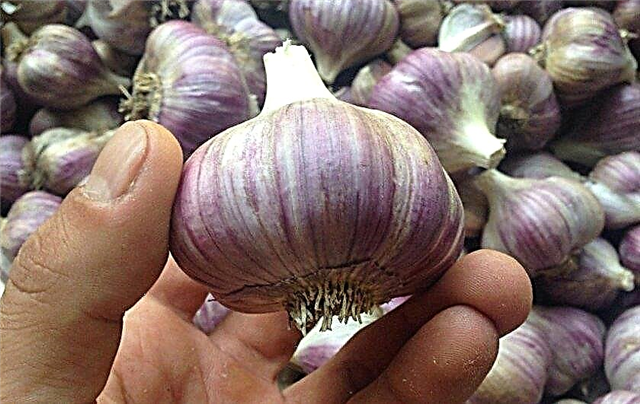
- "Ukrainian white" - It can land both in autumn and spring. This variety has no shooters, but this prevents it from being well stored. The weight of one head is 50–140 g, and the number of teeth in it is up to 12 pieces.

- "Spas" - Another brainchild of Ukrainian breeders from Lviv. It has a high yield and is stored for a long time. The head often has 7–9 teeth, and the bulb weighs 60–100 g. This garlic is also resistant to certain diseases, such as nematodes and fusarium.
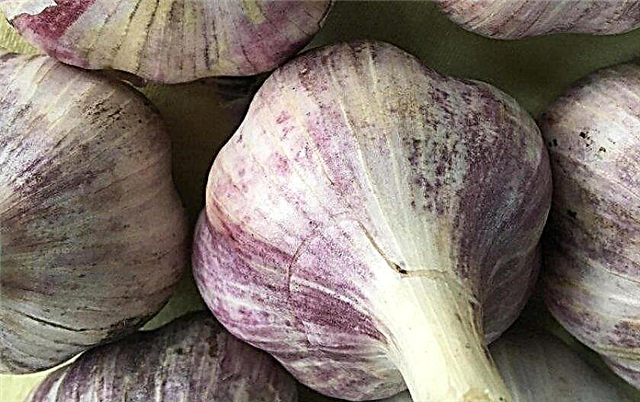
- "Jubilee Gribovsky" - This is a fairly old variety that has a sharp taste and is resistant to parasites and diseases. The weight of the bulb is about 40 g, and the number of cloves in it ranges from 5 to 8.

- "Jubilee 07" - this variety is well stored, gives a sufficiently large yield and does not suffer from Fusarium infection. The head has a white-violet color with stripes and consists of 8 teeth. The taste of garlic is not too spicy.

- "Reliable" - productive variety with a small spiciness, able to maintain its properties for up to a year, even in a warm room. The bulb has 6-7 strokes, a white husk with lilac stripes.
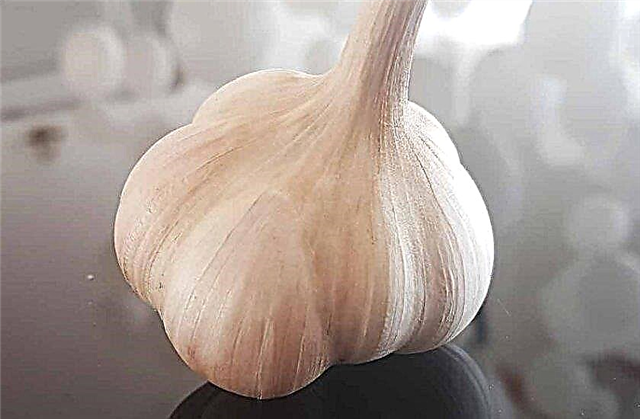
- "Purple Kharkov" - little susceptible to disease, has a high yield, refers to the arrow varieties. The head has a specific flattened shape and a purple color. The mass of the ripe onion is 30-60 g, and the number of teeth is on average 6 pieces.

- "Messidor" - The Dutch variety, which is characterized by high productivity, the bulb consists of 10 cloves and weighs 112 g. It tastes bitter.

When is it best to plant garlic?
It is not difficult to determine the most favorable period, you just need to follow the temperature of the air on the street, which at the time of garlic planting should be +12 ... + 15 ° С. Usually this temperature is set in late September or early November. But do not forget about the variability of the climate in different years and the region of planting, since the period of the desired temperature regime will depend on the combination of these factors.
In addition, the planting period of garlic can be calculated depending on the onset of the first cold weather. Thus, the teeth should be planted about a month and a half before the arrival of the first frost.
Did you know? Planting garlic for the winter is a more natural natural process than its summer cultivation. This is due to genetic memory, because the ancestor of garlic is spiky onion, growing in the mountainous regions of Central Asia, where eternal winter.
But the bulbs must be planted even earlier - in order for them to take up well, it is better to place the bulbs in the ground no later than April. This period is necessary so that planted cloves and bulbs have time to take root, which usually has a length of 10–20 cm, which will allow plants to better tolerate winter and give good shoots in spring. Also, newly planted teeth can hatch even before a cold snap, but this is a good sign that the garlic has taken root and even the most severe frosts will not harm him.
But what is better not to do is to plant garlic too soon, otherwise the culture will have time to germinate fully and will disappear before spring. The same applies to late planting - teeth and bulbs simply do not have time to take root and freeze, which naturally will lead to a complete loss of the crop.
Choosing a place for the garden
An important role is also played by the planting site of garlic. It is important to remember that this culture cannot be planted on the same bed every year. Experienced gardeners recommend moving the garlic bed to a new place every season, since garlic can only be returned to the old territory after 3-4 years.

A good choice for planting this crop would be a former bed with:
- pumpkins;
- legumes;
- early cabbage;
- early greens;
- cucumbers;
- bushes of berries and all annual plants.
They need to be removed from the beds in advance, and not on the eve of the planting of garlic.
Important! If something grew earlier in the garden where you decided to grow garlic, then you need to remember that this crop must be removed no later than the end of August and the beginning of September..
A poor choice for placing planting material would be a bed where tomatoes, potatoes and onions were grown, since when planting in these places, garlic will grow very poorly due to depletion of the soil by these crops. In addition, these plants are removed from the sites too late and you can simply not have time to prepare the soil for planting.
Among other things, we must not forget that garlic is very fond of the sun, so the garden should be in a well-lit, open area. If possible, care must be taken to ensure that the culture is not covered by a shadow, even if it does not turn for long.
The soil should be loose, not to let in air and excess water. In addition, the soil should be sufficiently nutritious and have a neutral pH level. In order for your bed to meet these parameters, you need to take care of the soil composition on it already a month before planting material is planted.

Do not plant garlic in the area where dirt is formed and rainwater stagnates, as well as on dense, clay and sour soil. You should avoid the land, in the impurities of which there is a large amount of peat.
Garlic can be planted in sandy areas, the culture will grow there, but very poorly. Due to the properties of sand, you will have to constantly produce abundant watering of the beds and carefully fertilize the soil, but even with this care, the heads are too small.
How to prepare the soil for planting garlic?
In order for garlic to give a good harvest in the spring, and in winter it is preserved in the ground and not frozen, you need to prepare the soil for planting in advance. In addition, this will help to avoid the occurrence of diseases in plants. At the same time, it is important to observe all terms and proportions, as well as carefully study the composition of the soil in order to make the right fertilizer in the soil.
Fertilizer land
The first top dressing of garlic is carried out in the spring, when the plants hatch well, and several sprouted leaves appeared from the ground. It is necessary to fertilize the soil comprehensively - in addition to organic top dressing, you can also use mineral and nitrogen. More specifically, urea and ammonium nitrate are usually used as fertilizers; their proportion in relation to water should be 2 tbsp. substances per 10 liters of liquid.
The next top dressing is carried out already at the beginning of the onion formation. This happens from mid to late June. The best way to feed during this period is nitrophoska. To knead a solution for fertilizer you need to take 2 tbsp. funds and dissolve them in 10 liters of water. For watering 1 m² of garlic beds usually use about 3-4 liters of this mixture. After you pour the garlic, you need to loosen the soil between the rows.

A good fertilizer for garlic is chicken droppings. Therefore, he will benefit from watering this fertilizer every 10 days. To prepare the product, you need to take 1 liter of litter and dilute it with 10 liters of water. The same applies to mullein, a similar amount of which is divorced from 8 liters of liquid. Both of these solutions can be used one bucket in an area of 5 m², pouring garlic to the root. But in no case should you water these two types of fertilizers at the same time so as not to burn the plant. In addition to organic fertilizers, you can also use mineral fertilizers, diluting 75 g of the product in 10 liters of water. This amount is enough for the same 5 m².
Good watering is very important for garlic, while the water should be heated in the sun, otherwise the culture will grow worse. In the case of a dry spring, you can save your crop by mulching the plants with humus or peat after the first watering. The layer of mulch should be 1-1.5 cm thick. And watering should be stopped already 20 days before the moment of digging up the culture.
In some cases, the bed is fertilized with lime - this is done in order to make acidic soil more favorable for growing garlic. In this case, a month before planting, in 1 m² of soil, 200 g of lime is poured, after which they carefully dig this place onto a full bayonet of shovels. Sometimes liming the soil, but then you have to abandon the cultivation of both winter garlic and spring. To carry out the liming procedure, in the fall, 250-300 g of lime are poured into the soil and dug. In the spring it is recommended to plant cabbage at this place and only after harvesting the cabbage is allowed to plant garlic.
In the case when the acidity of the soil is normal and there is no reason to refuse to plant garlic, the soil will also not hinder fertilizing. In this case, on 1 m² of area you need to make a mixture of 10-12 kg of humus, 1 tbsp. superphosphate and potassium sulfate. After mixing these ingredients and adding them to the soil, you need to dig the bed.
Important! Fresh manure should not be taken to fertilize the beds. It is best to take already rotted fertilizer, which has been lying for at least 4 years.
Formation of beds
In order to properly form a bed for garlic, you must first dig it up carefully, driving a shovel to a depth of about 20 cm, then the ground is leveled and compacted. After working with the earth, experienced gardeners are advised to treat the soil with copper sulfate to disinfect the soil. For 1 m² of beds it is necessary to take 1 liter of solution, for the manufacture of which 1 tbsp is taken. vitriol and divorced in a bucket of water. After watering the beds with a solution, this place needs to be covered with a film, which is removed right before the moment of planting of garlic.
This culture is usually planted with five-line ribbons, and the distance between the beds is about 20 cm. The plants themselves should also not be placed too tightly, and the spaces between them should be left at least 6-8 cm. If the variety of garlic is large, then the distance between the bulbs must be increased a couple cm. Each tooth should be planted in the ground to a depth of about 8 cm, but this indicator can also increase or decrease depending on the size of the planting material and soil structure. It is also worth remembering that a deeper placement of large teeth and bulbs contributes to their better wintering and development of the root system.
After planting the crop, it is recommended that the bed be covered with a 3-cm layer of peat, and after snow falls, you can throw it on the beds.
Video: Planting garlic in the winter
Gardens are not always perfectly even and are located on high ground. Sometimes it happens that the site is located in a lowland and there is stagnation of water and the accumulation of moisture. In this case, the best solution would be the artificial formation of high beds. Due to its configuration, such a bed will dry twice as fast as usual. But if the plot is swampy, then such properties will come in handy, since rainwater will leave faster, and the soil itself will warm up better even. In addition to a number of advantages, high beds also have their drawbacks, among which are high flowability and dry soil.
To form such a bed, a layer of earth with a height of about 20 cm needs to be thrown. There are no special requirements for the width, but most often it is made within about 1 m, which creates an optimal area for more convenient weeding. In addition, this place should be fenced so that the soil does not spread.
Preventive tillage
To prevent the occurrence of diseases in garlic, experienced gardeners advise cultivating the land before planting a 1% solution of copper sulfate. For this, 1 tbsp. the drug is diluted in 10 liters of water. On average, this amount is enough for an area of about 2 m².
The ready-made solution must be evenly distributed over the entire area where garlic will be planted in the future. This is best done with a watering can, and after watering, the bed is covered with a film.

There is another way to disinfect the soil before planting onions, for which urea is used. In this case, you will need 10-20 g of the product per 1 m², which must be scattered in the same amount throughout the garden. After the area is covered with fertilizer, it is watered with water until the fertilizer is completely absorbed.
Additional tips
In addition to the basic rules for planting garlic in the winter, it is worth taking advantage of the additional experience of gardeners to make your crop even better and more productive:
- Soil preparation. If your site is characterized by soil density, and the soil slowly absorbs moisture, then correct this situation by changing the composition of the soil. To prepare the beds for garlic, pour a bucket of sand and peat on each m² of beds. Then this area is deeply dug up, on a full bayonet of a shovel, and leveled.
- Soil compaction. In cases where the soil is too sandy, clay and humus must be added here. In this case, the clay should be sufficiently dry and crumbly. It needs to be thoroughly detailed, making a powder of the material, then mix the clay with sand and sprinkle over the site. On 1 m², pour 2 buckets of such a mixture.
- Acidity reduction. To improve the chemical composition of the soil using lime, using 250 g of the substance per 1 m² of territory. In addition, in addition to lime, you can prepare a mixture of river sand and clay, and then dig a bed.
- Soil preparation period. It is necessary to prepare the bed in advance, namely not later than 15–20 days before the alleged planting of garlic. So, if you decide to plant a crop at the end of the month, then you need to prepare the soil already from the first days.

- The value of processing material for planting. Many years of experience in growing garlic both by private farms and large farmers shows that the processing of cloves and bulbs has little effect on future crops. The subsequent agrotechnical actions are much more important.
- Planting teeth. It is not recommended to stick teeth into the ground with all their strength, otherwise you can cause them physical damage. For planting, you must first loosen the soil so that it is soft, after which it is allowed to carefully deepen the planting material. After planting, it is recommended to sprinkle the bed with ash, 200 g per 1 m².
- Watering. After planting, garlic does not require special watering, since it is quite moisture from rain. But if a whole month of rainfall was not observed, then it would be useful to water the crop once in the amount of one bucket per 1 m².
- Warming. If there is no snow yet, and the frosts are severe, you can cover the bed with fallen leaves, the layer of which should be 15–25 cm. A cloth, but not woven, will be placed on top of this insulation. In addition, you can use only fabric, and do not touch the leaves at all. If the colds are quite severe, then garlic can be covered with a mixture of manure and sawdust or humus, a layer of 20 cm. In spring, this shelter is removed, trying not to damage the young shoots. But this method is used extremely rarely and only in the northern regions.
- Loosening. After waiting a month after the snow melts, it is allowed to begin loosening the soil. To do this, walk between the rows for a couple of cm deep.
Basic rules for garlic care during cultivation
Winter garlic is not very whimsical to care if it is planted in open ground. This culture is resistant to cold and weather. If the garden bed is prepared correctly, and the garlic itself has managed to develop a good root system, then it will endure winter hard. But in the spring you have to take a little care of this culture.

To do this, it is important to observe the following recommendations:
- Growth Prep. With the advent of spring, the need for sheltering garlic disappears, so a couple of cm of the mulch layer is removed, freeing young growth. In addition, the shelter removed in time will allow the earth to warm up faster.
- Arrows. Closer to the twentieth of June, garlic is already actively growing and begins to produce arrows. This is not very good for the quality of future bulbs, so all the arrows need to be broken before they grow by 10 cm. If this is not done, then the plant’s strength will be spent on the development of the arrow and seeds, and the heads will be very small.
- Fertilizer. With the appearance of green feathers, garlic needs to be fed with nitrogen fertilizers, such as urea, manure or bird droppings. And in June - July it will be necessary to fertilize the garlic with ash, dissolving 200 g of this fertilizer in a bucket of water. It is important to remember that the best fertilizer for garlic will be organic fertilizers.
- Watering. Garlic likes watering, which should be plentiful enough, therefore, during the active growth of a crop, one should not skimp on water, of course, within reason. But by the time the heads are formed, the amount of water is reduced, and in the case when it rains on the street, additional watering should be stopped altogether. This is done in order to avoid plant diseases and rotting of the bulbs, which can lead to excess moisture.
- Weeding. Bulb growth does not hurt and once again loosen the soil. This procedure should be carried out after each watering or rain, and you also need to free the bed from weeds. But if your site is mulled, then these actions do not have to be performed too often.
- Garlic Harvest. It is recommended to harvest garlic in sunny weather, after the lower leaves turn yellow. This kind of garlic usually acquires by the last days of July or in the first half of August, a few weeks earlier than spring.
- Storage preparation. After the heads are dug, they must be dried in the sun for about 5 days and shortened the stem by 10–20 cm, as well as pruned roots. It is important to strictly monitor the timing of digging garlic, otherwise it will overripe, and the heads simply disintegrate.
Video: Tricks of planting garlic in the winter
Growing garlic is a rather rewarding activity, because it is not difficult, but gives a good result. Following simple recommendations, in a year you will be able to enjoy your harvest and get a whole storehouse of vitamins in one culture.











